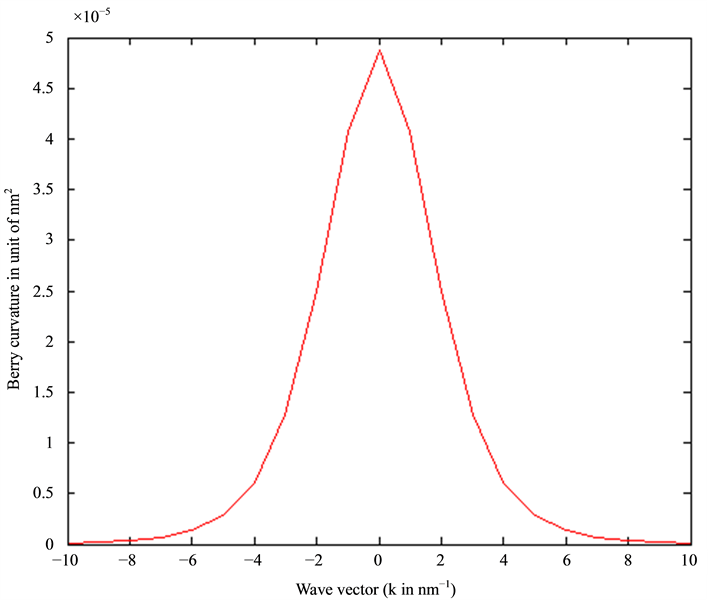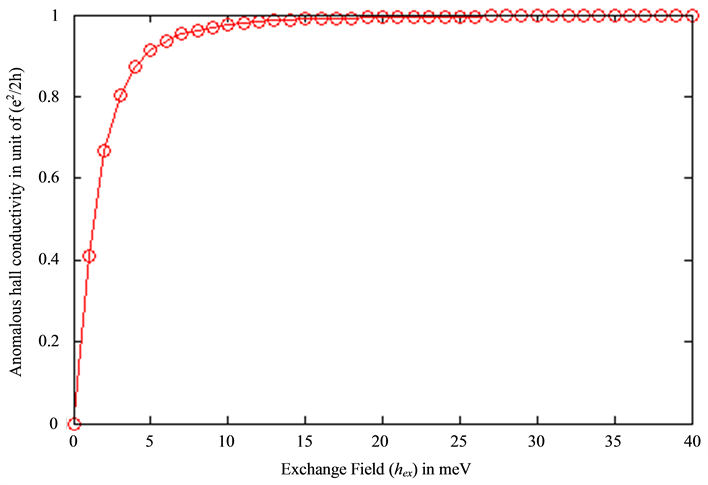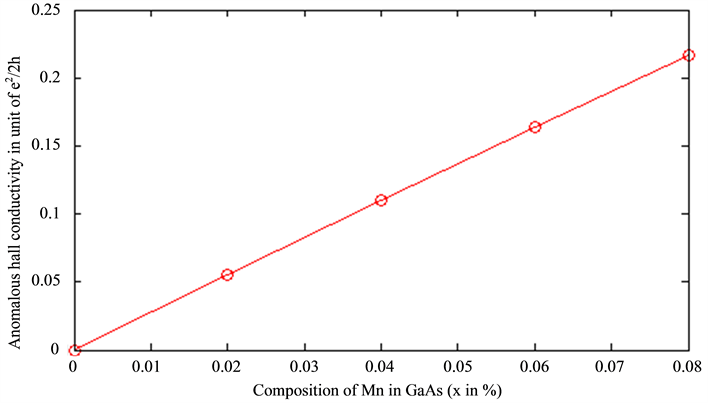World Journal of Condensed Matter Physics
Vol.05 No.03(2015), Article ID:58603,7 pages
10.4236/wjcmp.2015.53019
Berry Approach to Intrinsic Anomalous Hall Conductivity in Dilute Magnetic Semiconductors (Ga1−xMnxAs)
Sintayehu Mekonnen, P. Singh
Department of Physics, Addis Ababa University, Addis Ababa, Ethiopia
Email: hailemariamsintayeh@gmail.com, psinghgbpup@yahoo.com
Copyright © 2015 by authors and Scientific Research Publishing Inc.
This work is licensed under the Creative Commons Attribution International License (CC BY).
http://creativecommons.org/licenses/by/4.0/



Received 22 May 2015; accepted 2 August 2015; published 5 August 2015
ABSTRACT
We develop a model Hamiltonian to treat intrinsic anomalous Hall conductivity in dilute magnetic semiconductor (DMS) of type (III, Mn, V) and obtain the Berry potential and Berry curvature which are responsible for intrinsic anomalous Hall conductivity in Ga1−xMnxAs DMS. Based on Kubo formalism, we establish the relation between Berry curvature and intrinsic anomalous Hall conductivity. We find that for strong spin-orbit interaction intrinsic anomalous Hall conductivity is quantized which is in agreement with recent experimental observation. In addition, we show that the intrinsic anomalous Hall conductivity (AHC) can be controlled by changing concentration of magnetic impurities as well as exchange field. Since Berry curvature related contribution of anomalous Hall conductivity is believed to be dissipationless, our result is a significant step toward achieving dissipationless electron transport in technologically relevant conditions in emerging of spintronics.
Keywords:
Berry Potential, Berry Curvature, Kubo Formalism, Anomalous Hall Conductivity

1. Introduction
In 1879, Edwin H. Hall discovered that when a conductor carrying longitudinal current was placed in a vertical magnetic field, the carrier would be pressed against the transverse side of the conductor, which led to an observed transverse voltage. This is called the Hall effect (HE) [1] . After almost one century, the quantum Hall effect was discovered by K. von Klitzing in 1982 in a two-dimensional electron gas (2DEG) at low temperature and strong magnetic field [2] . However, in ferromagnetic metals like Fe, Co, and Ni, and newly discovered DMSs like Ga1−xMnxAs the Hall effect is anomalous and controlled more by magnetization than by Lorentz forces [3] [4] , called the anomalous Hall resistivity and the phenomenon is known as anomalous Hall effect (AHE). This phenomenon attracted both experimental and theoretical interest due to its potential application in emerging science of spintronics [5] . The origin of anomalous Hall effect is believed to be due to spin-orbit (SO) interaction in the presence of spin polarization [6] . On the other hand, DMS of type (III, Mn, V) spin polarization is due to exchange interaction between localized Mn2+ 3d5+ spins and holes introduced by substitution of Mn2+ by Ga3+ [7] . There are two popular theories to explain anomalous Hall effect seen in ferromagnetic system, named as intrinsic and extrinsic theories,both of these theories involve the SO interaction. The intrinsic theory was first time proposed by Karplus and Luttinger (KL) [8] . It required no impurity (the intrinsic scenario) and extrinsic theory, which was proposed by Smit and Berger; they pointed out the role of the impurity scatterings in the steady state equilibrium and hence in the AHE [9] [10] . Among others, the intrinsic theory dominantly plays a rule in dilute magnetic semiconductors of type (III, Mn, VI) and the current understanding on intrinsic theories of anomalous hall conductivity allows us to reformulate it with Berry curvature of quasi-particles [11] -[13] . Accordingly, intrinsic AHE results from curvature of electrons below the Fermi surface, as a consequence of the spin-orbit coupling induced topological properties in Bloch bands [13] . Although this anomalous Hall effect (AHE) has become a standard tool to determine the magnetization of ferromagnet and has been known for more than a century, its mechanism is still under debate. Particular attention has been paid to intrinsic mechanisms based on the Berry phase. According to recent experimental result, the intrinsic version of AHC is quantized [14] .
In this paper we theoretically study anomalous Hall conductivity. The paper is organized as follows. Firstly we develop model Hamiltonian on basis of above discussion, which obtains analytical expression for Berry potential and Berry curvature; secondly after applying Quantum Kubo formulism the connection between Berry curvature and intrinsic Anomalous Hall conductivity is established.
2. Theoretical Formulation
We consider two dimensional hole gas (2 DhG) in the presence of Spin-orbit coupling taking the form of the usual Rashba term, exchange field, kinetic energy of itinerant holes in the system.
 (1)
(1)
where
 (2)
(2)
 and
and  are usual kinetic energy of carriers (holes) and band mass of charge carriers (holes) respectively
are usual kinetic energy of carriers (holes) and band mass of charge carriers (holes) respectively
 (3)
(3)
Here, hex is exchange field resulting from exchange interaction between localized Mn 3d5 spins and valence band holes introduced by substitution of Mn2+ by Ga3+ Our approach is based on mean field treatment and magnetization along perpendicular to kx and ky plane or along z axis(along the direction of quantization).  is spin-orbital interaction term in the form of Rash Hamiltonian which accounts that orbital motion of carriers coupled with its spin is given by
is spin-orbital interaction term in the form of Rash Hamiltonian which accounts that orbital motion of carriers coupled with its spin is given by
 (4)
(4)
Here,  and
and  are Dirac spin operators along x and y direction respectively and
are Dirac spin operators along x and y direction respectively and  and
and  are wave vectors along x and y direction respectively and
are wave vectors along x and y direction respectively and  Rashba type of spin-orbit coupling constant. Using Equations (2), (3) and (4) into Equation (1), we rewrite the model Hamiltonian as
Rashba type of spin-orbit coupling constant. Using Equations (2), (3) and (4) into Equation (1), we rewrite the model Hamiltonian as
 . (5)
. (5)
In 2D spin space, application of diagonalization procedures in Equation (5) generates two eigenvalues
 (6)
(6)
And we have obtained the corresponding normalized eigenvectors for spinor part and its complex conjugate
 (7)
(7)
 (8)
(8)
2.1. Berry Potential and Berry Curvature
Berry potential in momentum space along α, β and γ where α, β and γ designates x, y and z coordinate system respectively were defined in terms of periodic spinor Bloch state and in bands as [15]

Here 
Berry potential (connection) along x and y direction in k space as follows


The Berry curvature along perpendicular to α, β and γ plane is defined using analogical expression for real space magnetic field [15] .

In two dimensional systems we rewrite as,


Using Equation (9) into Equation (14),

This can be written as compact form after introducing commutation relation and straightforward simplification as

Since 


After introducing identity

After Series of steps we have obtained analytical expression for k-space Berry curvature as

Here, 
Equation (19) is general equation of K-space Berry curvature in 2 DS having periodic part of eigenfunction (Spinor part) 

In Equation (20), 


which were obtained using our model Hamiltonian in Equation (5)


Introducing three dimensional unit vector along x, y and z direction, in two dimensional plane in k space in terms Eigen values as follows

where

The Berry curvature in Equation (24) is responsible for intrinsic Anomalous Hall Conductivity seen in system under consideration.
The connection between Berry curvature and Anomalous Hall conductivity is obtained using Quantum Kubo formalism in the following section.
2.2. Quantum Kubo Formalism and AHC
The Kubo formula for Hall conductivity for current-current correlated system is given by [16]

V is volume of system, 









On view of Equation (20), right side of Equation (26) inside the bracket gives

Here we have replaced the band indices n and m via ± which designates lower occupied (−) and upper empty band (+). In continuous limit it is convenient to replace summation into integration. Therefore, Equation (27) becomes

Plugging Equation (24) into Equation (28), after some algebra we obtained AH conductivity for lower occupied states at T = 0,

In Equation (29) we have considered that at Temperature (T = 0) upper band (+) is empty and has nothing contribution to Hall conductivity. Equation (29) integrated to give

3. Discussion and Conclusions
From Equation (8) and Equation (9) we can observe that in absence of spin-orbital coupling (αR = 0) Berry potential along x and y direction in k-space goes to zero and in similar manner the Berry curvature in Equation (24) also vanishes as (αR = 0) Or/and (hex = 0). Therefore, the origin of Berry potential (connection) as well as Berry curvature in a DMS of type (III, Mn, V) is spin-orbital interaction and exchange field (hex). As seen in Figure 1, the Berry curvature is peaked at k = 0, and from Equation (27) the curvature is proportional to AHC; hence the maximum anomalous Hall conductivity can be attained for k = 0.
From Equation (30), if

Figure 1. The variation of Berry curvature as function of wave vector k for material constant of intrinsic Rashba spin-orbit coupling constant (αR = 10 ÅeV) and exchange field (hex = 40 meV).
Equation (31) reveals that intrinsic anomalous Hall conductance is almost quantized which is also supported by recent experimental results [14] [17] [18] . On the other hand, from Equation (27), the intrinsic anomalous Hall conductance is simply the sum of the Chern numbers (the total Berry flux through the BZ) for all the occupied band.
From Case II, integrating Equation (29) from 


Our analytical results obtained from Equation (30) are similar to result obtained for intrinsic contribution of anomalous hall conductance by classical approach [19] .
In Figure 2, we have plotted the variation anomalous Hall conductivity as function exchange field. As can be seen in Figure 1, when there is no magnetic interaction (

In Figure 3, anomalous Hall conductivity increases monotonically as composition of magnetic dopant (x) increases. Hence, it is possible to control intrinsic anomalous Hall conductivity by changing the concentration of magnetic impurities.
In conclusion we say that, at low temperature, in the presence of strong spin-orbit interaction, the anomalous Hall conductivity is quantized. The interplay between spin-orbit interaction and exchange field introduces Berry curvature which is responsible for intrinsic anomalous Hall effect in dilute magnetic semiconductors (Ga1−xMnxAs). Anomalous Hall conductivity increases monotonically as composition of magnetic dopant (x) increases in mean field theory treatment
Figure 2. The Variation of Anomalous Hall conductivity as function of exchange field for material constant of spin-orbit splitting (
Figure 3. Anomalous Hall conductivity as function of composition of magnetic dopant for material constants of spin-orbit splitting (
Acknowledgements
This work was supported by the school of Graduate studies of Addis Ababa University, Addis Ababa, Ethiopia and Arbaminch University, Arbaminch, Ethiopia.
Cite this paper
SintayehuMekonnen,P.Singh, (2015) Berry Approach to Intrinsic Anomalous Hall Conductivity in Dilute Magnetic Semiconductors (Ga1-xMnxAs). World Journal of Condensed Matter Physics,05,179-186. doi: 10.4236/wjcmp.2015.53019
References
- 1. Hall, E. (1879) On a New Action of the Magnet on Electric Currents. American Journal of Mathematics, 2, 287-292. http://dx.doi.org/10.2307/2369245
- 2. Tsui, D.C., Stormer, H.L. and Gossard, A.C. (1982) Two-Dimensional Magneto Transport in the Extreme Quantum Limit. Physical Review Letters, 48, 1559. http://dx.doi.org/10.1103/PhysRevLett.48.1559
- 3. Chen, H., Niu, Q. and MacDonald, A.H. (2014) Anomalous Hall Effect Arising from Noncollinear Antiferromagnet. Physical Review Letters, 112, Article ID: 017205.
http://dx.doi.org/10.1103/PhysRevLett.112.017205 - 4. Hsu, S., Lin, C.P., Sun, S.J. and Chou, H. (2010) The Role of Anomalous Hall Effect in Diluted Magnetic Semiconductors. Applied Physics Letters, 96, Article ID: 242507. http://dx.doi.org/10.1063/1.3431294
- 5. Idrish Miah, M. (2007) Observation of the Anomalous Hall Effect in GaAs. Journal of Physics D: Applied Physics, 40, 1659. http://dx.doi.org/10.1088/0022-3727/40/6/013
- 6. Mitra, P., Misra, R., Hebard, A.F., Muttalib, K.A. and Wölfle, P. (2007) Weak-Localization Correction to the Anomalous Hall Effect in Polycrystalline Fe Films. Physical Review Letters, 99, Article ID: 046804.
http://dx.doi.org/10.1103/PhysRevLett.99.046804 - 7. Jungwirth, T., Niu, Q. and MacDonald, A.H. (2002) Anomalous Hall Effect in Ferromagnetic Semiconductors. Physical Review Letters, 88, Article ID: 207208.
http://dx.doi.org/10.1103/PhysRevLett.88.207208 - 8. Karplus, R. and Luttinger, J.M. (1954) Hall Effect in Ferromagnetism. Physical Review, 95, 1154.
http://dx.doi.org/10.1103/PhysRev.95.1154 - 9. Nunner, T.S., Zaránd, G. and von Oppen, F. (2008)Anomalous Hall Effect in a Two Dimensional Electron Gas with Magnetic Impurities. Physical Review Letters, 100, Article ID: 236602.
http://dx.doi.org/10.1103/PhysRevLett.100.236602 - 10. Liu, S., Yan, Y.-Z. and Hu, L.-B. (2012) Characteristics of Anomalous Hall Effect in Spin-Polarized Two-Dimensional Electron Gases in the Presence of Both Intrinsic, Extrinsic, and External Electric-Field Induced Spin—Orbit Couplings. Chinese Physics B, 21, Article ID: 027201.
http://dx.doi.org/10.1088/1674-1056/21/2/027201 - 11. Sundaram, G. and Niu, Q. (1999) Wave-Packet Dynamics in Slowly Perturbed Crystals: Gradient Corrections and Berry-Phase Effects. Physical Review B, 59, 14915-14925.
- 12. Nagaosa, N., Sinova, J., Onoda, S., MacDonald, A.H. and Ong, N.P. (2010) Anomalous Hall Effect in Antiferromagnetic Systems. Reviews of Modern Physics, 82, 1539.
http://dx.doi.org/10.1103/RevModPhys.82.1539 - 13. Boldrin, D. and Wills, A.S. (2012) Anomalous Hall Effect in Geometrically Frustrated Magnets. Advanced Condensed Matter Physics, 2012, Article ID: 615295. http://www.hindawi.com
- 14. Chang, C.-Z., et al. (2013) Experimental Observation of the Quantum Anomalous Hall Effect in a Magnetic Topological Insulator. Science Magazine, 340, 167-170.
http://www.sciencemag.org/content/340/6129/167.abstract - 15. Gradhand, M., Fedorov, D.V., Pientka, F., Zahn, P., Mertig, I. and Györffy, B.L. (2012) First-Principle Calculations of the Berry Curvature of Bloch States for Charge and Spin Transport of Electrons. Journal of Physics: Condensed Matter, 24, Article ID: 213202.
http://dx.doi.org/10.1088/0953-8984/24/21/213202 - 16. Crépieux, A. and Bruno, P. (2001) Theory of the Anomalous Hall Effect from the Kubo Formula and the Dirac Equation. Physical Review B, 64, Article ID: 014416.
- 17. Bestwick, A.J., Fox, E.J., Kou, X.F, Pan, L., Wang, K.L. and Goldhaber-Gordon, D. (2015) Precise Quantization of the Anomalous Hall Effect Near Zero Magnetic Field. Mesoscale and Nanoscale Physics, 114, Article ID: 187201.
- 18. Chang, C.-Z., et al. (2013) The Complete Quantum Hall Trio. Science, 340, 153-154.
http://www.sciencemag.org/content/early/recent / 14 March 2013 / Page 10.1126/science.1234414 - 19. Sinitsyn, N.A., MacDonald, A.H., Jungwirth, T., Dugaev, V.K. and Sinova, J. (2007) Anomalous Hall Effect in a Two-Dimensional Dirac Band: The Link between the Kbo-Streda Formula and the Semiclassical Boltzmann Equation Approach. Physical Review B, 75, Article ID: 045315.
http://dx.doi.org/10.1103/PhysRevB.75.045315






